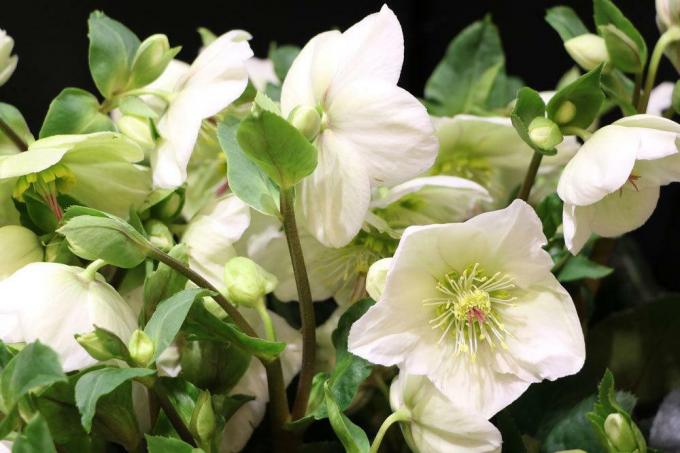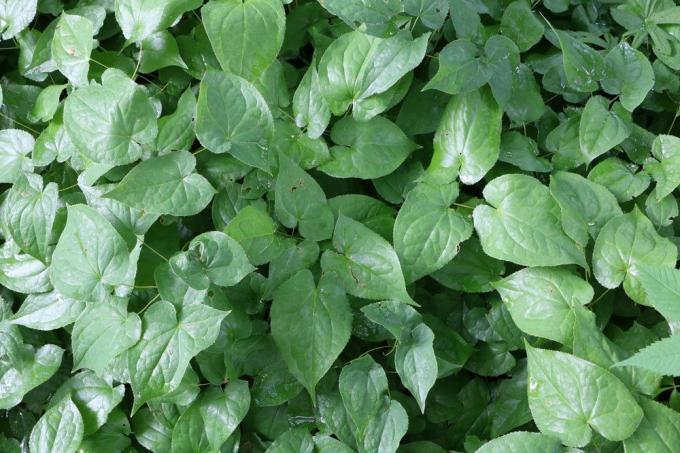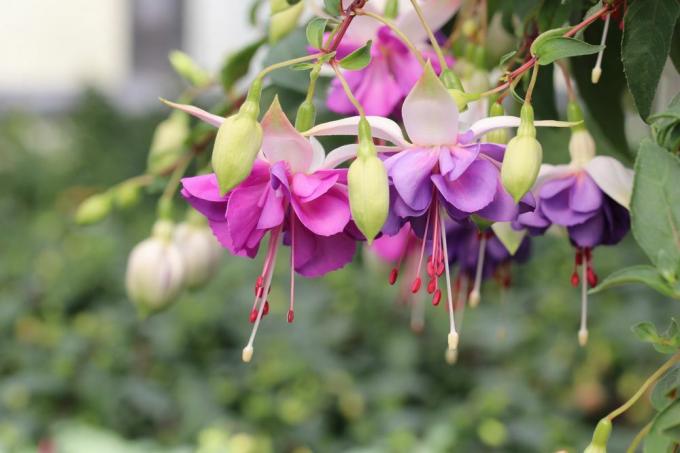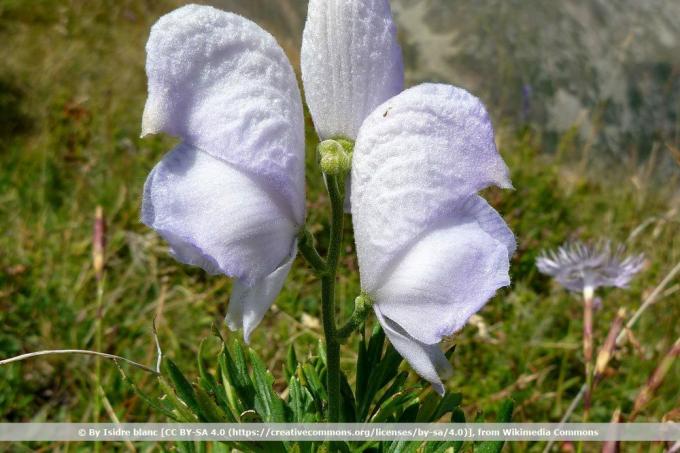
table of contents
- Shadow flowers
- Shade flowers that stay small
- Medium-height shade flowers
- Tall and very tall shade flowers
Every garden owner is sure to know shady places in the garden where nothing wants to grow. That is why they are usually neglected. But shady locations also offer a surprising number of design options. However, not all shadows are created equal and there are subtle differences. While full shade is extremely poor in sun, areas in partial or scattered shade enjoy up to five hours of sun a day with constantly changing light and shadow plays.
Shadow flowers
Low
- Günsel, Galgelkraut, Güldengünsel (Ajuga reptans)
- Alpine silver mantle (Alchemilla alpina)
- Dwarf lady's mantle (Alchemilla erythropoda)
- Rock Lady's Mantle (Alchemilla saxatilis)
- Local bear's garlic, wild garlic (Allium ursinum)
- Ray anemone (blue) (Anemone blanda)
- Wood anemone (Anemone nemorosa)
- Dwarf Columbine (Aquilegia flabellata var. kurilensis 'Rosea')
- Native hazel root (Asarum europaeum)
- Bald dwarf spar (Astilbe glaberrima var. saxatilis)
Medium height
- Maple leaf (Aceriphyllum rossii)
- Large-leaved lady's mantle (Alchemilla mollis)
- Great wood anemone (Anemone sylvestris)
- Iberian spring anemone (Anemone palmata)
- Double columbine (Aquilegia vulgaris 'Plena')
- Common wood acre (Aquilegia vulgaris)
- Veined Arum (Arum italicum)
- Red-flowered umbellate (Astrantia carniolica 'Rubra')
- Large star umbels (Astrantia major 'Lars')

High and very high
- Silver candle (Actaea acerina)
- Japan mock anemone (Anemonopsis macrophylla)
- Long-spurred Beetakelei (Aquilegia caerulea-Hybride)
- Arends splendor spar, (Astilbe Arendsii hybrid 'Fanal')
- Korean bellflower (Campanula takeshimana)
- Nettle-leaved bellflower (Campanula trachelium)
- Peach-leaved bellflower (Campanula persicifolia 'Grandiflora')
- Giant fescue (Festuca gigantea)
- Knotweed (Persicaria virginiana 'Painters Palette')
- Meadow rue (Thalictrum rochebrunianum)
- White forest bellflower (Campanula latifolia)
- Kamchatka Forest Goat's Beard (Aruncus dioicus var. kamtschaticus)
- Columbine (Aquilegia formosa)
Further flowers for shady places are explained in more detail below.
Shade flowers that stay small
Christmas roses (Helleborus)
When the garden is still in hibernation, the Christmas roses, also known as snow roses, make their grand entrance. In the middle of winter, depending on the variety, they open their snow-white, reddish or black-bluish flowers. They are only 10 - 30 cm tall and feel most comfortable in partially shaded to shady places, under deciduous trees.

Tip: At locations where the Christmas rose feels particularly comfortable, it can reach an age of over 30 years.
Hepatica (Hepatica nobilis)
Relatively early, from February / March to April, the distinctive liverwort, which is related to the anemones, blooms. Its flowers close in the evening and when it rains. The bracts grow a little longer every day and grow to almost double their original size by the end of the flowering period. The new leaves are formed towards the end of the flowering period. The 5 - 10 cm small shade flowers love partially shaded and shady places and are perfect for under- and between plants.

Tip: Liverworts are poisonous in all parts when fresh; when dried they are non-toxic.
Hard-working Lieschen (Impatiens)
In shady locations, the hardworking Lieschen shows what it's made of and surprises with an abundance of flowers. With a flowering time from May to frost, it lives up to its name, with flowering increasing in summer. The flowers can be single or double, white, pink, red, orange, or purple. The plants reach heights of growth between 20 and 35 cm.

White Elven Flower (Epimedium x youngianum niveum)
As a ground cover or underplanting of trees and shrubs, these flowers are the star among the shade flowers. With its delicate shoots, heart-shaped leaves and, in particular, the bright white flowers sitting in rows on filigree flower stalks, it brings color to dark garden corners. It was Perennial of the Year 2014. The flowering period is from April to May and the height is between 15 and 25 cm. We recommend 9 pieces per square meter.

Elven flower 'Orange Queen'
A real eye-catcher in shady locations are these evergreen elven flowers with their intense orange flowers, for example as compact ground cover. They also bloom from April to May. Its height is between 25 and 30 cm, so it is slightly larger than the white elven flower. These flowers are generally very undemanding in terms of location and care.
Tip: Due to their vigor, these shade flowers can easily overgrow competitors in the bed.
Grape lily 'Monroe White'
This grape lily is one of the few lilies that blooms even in the shade. In addition to the widespread purple variety, 'Monroe White' with its pure white flower clusters is a real rarity and a brilliant point of light for shady places. The white, splendidly shaped flowers form a striking contrast to the evergreen, grassy foliage. The height of these shade flowers is between 20 and 30 cm.

Medium-height shade flowers
Hostas / heart lilies (hosta)
- Foliage is the greatest ornament of these plants
- Leaves can be heart-shaped or lanceolate
- Foliage dark green, yellow green, cream white or steel blue
- Depending on the variety, also multicolored or varnished in white
- Flowering period from June / July to August / September
- white to purple inflorescences
- Flowers sit on almost bare stems
- The smallest varieties grow to heights of 15-20 cm
- Inflorescences of the largest varieties reach up to 90 cm in height

Japanese toad lily (Tricyrtis hirta)
The toad lily, also known as the tiger star, comes from Japan and is a very noble and filigree shade plant that is reminiscent of an orchid on the outside. These flowers delight with their heart-shaped leaves. But above all with their whitish to light purple and reddish purple dotted flowers and a relatively long flowering period. This extends from July / August to October. The stature heights are between 30 and 50 cm.

Dwarf star umbel 'Ruby Wedding'
This abundantly blooming, 30 - 40 cm high dwarf star umbel thrives particularly well in partially shaded or partially shaded areas. shadier places. The advantages of this plant lie in the relatively rare blood-red color of the flowers. The main flower is usually followed by a second flower. With its long flower stalks, this star umbel also looks great in a bouquet.

Double autumn anemone (Anemone japonica hybrid)
Planted in groups from August to October, this delightful, richly blooming autumn anemone forms thick carpets of dark green leaves and an abundance of pink, double flowers. It loves partially shaded and shady places and reaches heights of 70 - 90 cm. Together with grasses, ferns and other shade flowers, it sets extraordinary accents.

Fuchsias (Fuchsia)
The most spectacular thing about these flowers is their delicate and mostly multi-colored bell-shaped blossoms, which differ in shape and color depending on the variety. They bloom incessantly all summer long into autumn, whereby, according to their origin, they feel particularly comfortable in rainy summers. Depending on the variety, the stature heights vary between 20 and 500 cm.

Tip: As a rule, fuchsias do not tolerate frost and must therefore overwinter in a frost-free area.
Tall and very tall shade flowers
Foxglove (digitalis)
The foxglove is one of the rather short-lived shade flowers, as it only grows as a biennial. He feels most comfortable in partial shade or shade. In the first year it forms an evergreen, indigenous leaf rosette with approx. Stalked leaves 20 cm long. In the second year, from June to August, white, yellow, pink, red or purple inflorescences up to 150 cm high develop from this rosette of leaves.

Note: This plant is highly poisonous in all parts.
Silver candle Actaea (Cimicifuga)
- grows in the light shade of trees, bushes or hedges
- Flowering time, depending on the variety, from June to October
- white, cream or pink, fragrant flower candles
- at the time of flowering, stature heights of 40 - 200 cm are reached
- Leaves green or reddish, pinnate and ovate to oblong
- Can be easily combined with other types of silver candles
- ideal partner for planting ferns and ornamental leaves

White mountain monkshood 'Snow White' (Aconitum napellus 'Snow White')
The white mountain iron hat, also known as garden iron hat, is a very graceful perennial that is well suited for shady places. Its up to 150 cm high, loose, yellowish-white flower clusters are particularly effective against dark backgrounds in cool locations. Each flower cluster consists of many large, helmet-shaped individual flowers. The flowering time is in midsummer from July to August. The leaves of these flowers are dark green, slit and shimmering silvery. The monkshood can be combined well with a star umbel, goatee or forest bellflower.

High forest goat's beard (Aruncus dioicus)
The tall forest goat's beard is an imposing perennial for both shady and partially shaded garden areas. The most striking thing about this attractive plant is its large, cream-colored, feathery panicles of flowers that adorn the plant from early June to late July. Originally a garden plant and can now be found in many gardens. It grows broad and upright, 150-180 cm high and up to 100 cm wide. Good partners in planting these shade flowers are z. B. Monkshood, foxglove, splendid spar and ferns.

Meatberry / upright slimeberry (Sarcococca confusa)
- upright slimeberry tolerates shade very well
- flowers from mid / late January to March
- small, creamy white flower clusters with an intense fragrance
- Bushy, upright, well branched habit
- after approx. 10 years it reaches a height of 150 cm and a width of 200 cm
- Leaves dark green glossy, ovate-elliptical
- Fruit decoration, 5 mm large, shiny black berries
- Berries not suitable for consumption

High meadow rue 'Elin' (Thalictrum rochebruneanum 'Elin')
The greatest adornment of this filigree, tall, magnificent perennial are its panicle-like, fragile, pink to pale purple inflorescences. They seem to float above the silvery-green, bluish shimmering leaves. The 5 - 10 cm large single flowers sit on up to 250 cm high branched, purple-colored flower stalks. Flowering time is from July to August.

